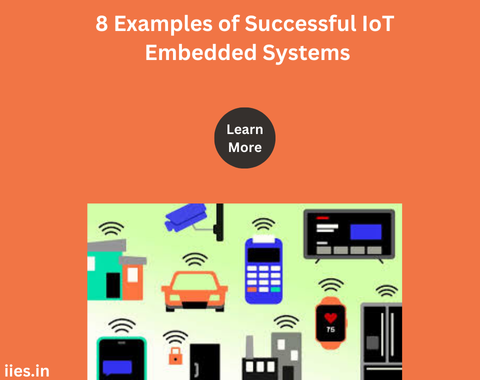
The Internet of Things (IoT) has revolutionized numerous industries by enabling the integration of smart, interconnected devices that enhance efficiency, safety, and convenience. Embedded systems play a critical role in IoT, providing the necessary computing power and connectivity.
Here are eight successful examples of IoT embedded systems that showcase the transformative potential of this technology.
Smart home automation systems, such as those developed by companies like Nest and Philips Hue, use IoT embedded systems to control lighting, heating, and security. These systems allow users to manage home environments through their smartphones or voice commands, providing convenience and energy savings. For example, Nest’s Learning Thermostat uses embedded sensors and algorithms to learn homeowners’ schedules and optimize heating and cooling, reducing energy consumption.
Wearable health monitors, like the Fitbit and Apple Watch, integrate IoT embedded systems to track physical activity, heart rate, sleep patterns, and other health metrics. These devices collect and analyze data in real-time, providing users with insights into their health and fitness. Advanced models can even detect irregular heartbeats or falls, alerting users and emergency contacts to potential health issues.
Smart agriculture solutions utilize IoT embedded systems to monitor and manage farming operations more efficiently. Systems like John Deere’s precision agriculture equipment use sensors and GPS technology to optimize planting, watering, and harvesting. These IoT-enabled systems help farmers increase crop yields, reduce resource usage, and improve sustainability.
Industrial IoT systems, such as Siemens’ MindSphere, leverage embedded systems to enhance manufacturing processes and equipment maintenance. These systems collect data from sensors embedded in machinery, allowing for predictive maintenance and reducing downtime. By analyzing performance data, companies can optimize production lines and improve overall efficiency.
Smart city initiatives, like those implemented in cities such as Barcelona and Singapore, use IoT embedded systems to improve urban living conditions. These systems manage traffic flow, monitor air quality, control street lighting, and even manage waste collection. For instance, smart traffic lights use real-time data to optimize traffic flow, reducing congestion and emissions.
Connected cars, developed by companies like Tesla and General Motors, are prime examples of IoT embedded systems in the automotive industry. These vehicles use embedded sensors and communication systems to offer features like autonomous driving, real-time traffic updates, and remote diagnostics. Tesla’s over-the-air software updates demonstrate the power of IoT, enabling continuous improvement of vehicle performance and safety features.
Smart retail systems, such as Amazon Go stores, integrate IoT embedded systems to enhance the shopping experience. These stores use a combination of sensors, cameras, and embedded systems to track customers and products, enabling a checkout-free shopping experience. Customers simply walk out with their purchases, and their accounts are automatically charged, providing a seamless and convenient shopping experience.
IoT embedded systems are transforming energy management through smart grids and intelligent energy meters. Companies like Schneider Electric provide solutions that monitor and manage energy consumption in real-time. Smart grids use embedded systems to balance energy distribution, integrate renewable energy sources, and respond to fluctuations in demand, improving efficiency and reducing costs.
The integration of IoT embedded systems across various industries demonstrates the vast potential of this technology to enhance efficiency, safety, and convenience. From smart homes and wearable health monitors to industrial systems and smart cities, these examples highlight how IoT is shaping the future. As technology continues to advance, the impact of IoT embedded systems is likely to grow, further transforming our world.
Indian Institute of Embedded Systems – IIES